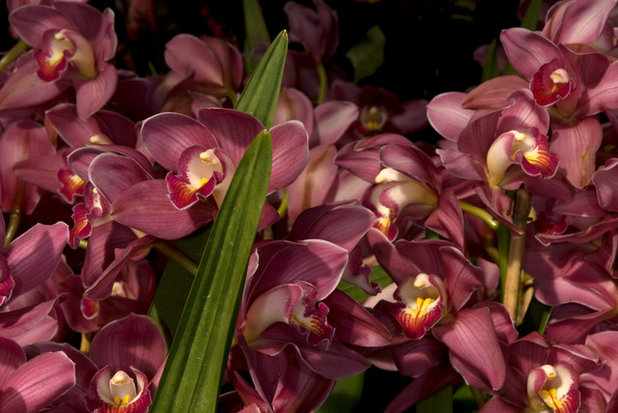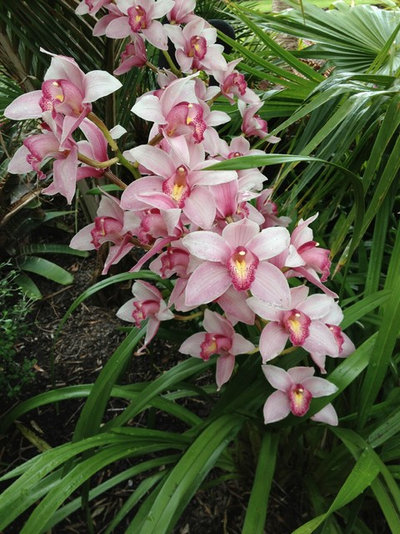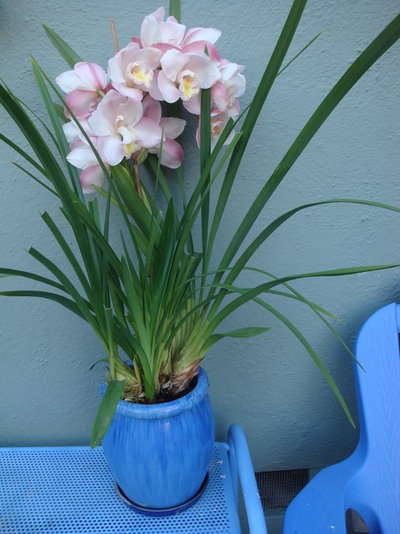Cymbidiums are a welcome addition to a garden or patio as well as a home, producing 3- to 4-foot-long sprays of up to 30 flowers on multiple stems from winter through spring. Even out of flower, they have arching leaves that add texture to a garden.
For those who live in warm-winter climates, cymbidiums are the “outdoor” orchids, surviving temperatures that can reach as low as 28 degrees Fahrenheit (-2 degrees Celsius); for those with a harsher winter climate, they can live outdoors through the summer, then overwinter indoors while you enjoy their blooms. And if you love the look but don’t really have the room for a large plant, miniature and dwarf varieties are becoming more readily available. If you do get one of these, check their growing requirements. They often do better if kept indoors year-round.

The New York Botanical Garden

LANZSCAPES
You can grow cymbidiums directly in the ground, but most people prefer to plant them in pots. This allows you the flexibility to move them around — to a prominent spot when they flower, to a less noticeable spot as an added bit of garden foliage and texture, or indoors or under shelter when low temperatures threaten them or if frost might damage the blooms.

KDL Architects
For the most part, cymbidiums do best in bright, indirect light. Their leaves will let you know if they’re getting enough light. They’re yellowish green when they’re thriving and darker, even with a bluish cast, when they aren’t getting enough light. The ideal location for a cymbidium would be a spot that gets afternoon shade or mottled light through the day.
Nighttime temperature lows are more crucial than daytime highs for cymbidiums. They can take heat, though they should be sheltered from direct sun and given additional water and humidity. But they need lower nighttime temperatures during the autumn and winter to bloom. Although they can handle lower temperatures, it’s prudent to bring them inside if the temperature threatens to go below 35 degrees Fahrenheit (2 degrees Celsius).
You’ll also need to provide plenty of air circulation. Plants grown outdoors are usually fine; those grown indoors might need a fan near them when windows aren’t open.

Studio Marcelo Brito
Cymbidiums need regular watering, especially from spring through fall. Once a week is usually fine, although you may need to adjust the frequency, depending on heat and humidity. The potting mix should not dry out; check it by poking your finger about an inch into the potting medium. Water thoroughly with tepid water in the morning and let the container drain completely. Cut back on water during the winter.
Use the recommended amount of liquid orchid fertilizer at one-quarter strength whenever you water during the first part of the year, from January to June; then cut back to quarter-strength fertilizer every other week through December.

Repot only when the roots are very crowded; orchids do best when they’re starting to outgrow the pot. Even then, go only slightly larger in pot size. Potting mediums designed for orchids are your best bet. Because the combined weight of these larger plants and terra-cotta or ceramic pots can get heavy, you might want to use plastic pots when repotting. You can always disguise them with a cachepot or another decorative container. Repot when the plant has finished blooming, water lightly until you see new growth and then resume regular care.
Remove the flower spikes once they finish blooming and have turned brown, and continue with general care. Starting in about November, place them in a spot with lower nighttime temperatures, generally between 45 and 60 degrees Fahrenheit (7 to 16 degrees Celsius). As long as you get sufficient nighttime lows in the fall and the flower stalks aren’t damaged by frost, your cymbidium should rebloom the following winter.
Tip: When the new flower spike emerges, stake it to provide support so it will grow straight.
More: Orchids 101: Get Started Growing Orchids at Home
More guides to growing houseplants





